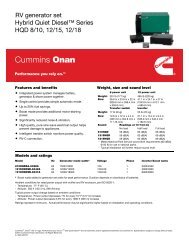Air Brake Manual
Air Brake Manual
Air Brake Manual
You also want an ePaper? Increase the reach of your titles
YUMPU automatically turns print PDFs into web optimized ePapers that Google loves.
On the pre-trip air brake inspection (Section 9), you<br />
must ensure that the parking brake spring is not<br />
manually caged or it will not expand and apply the<br />
brake. The brake chambers should be checked for<br />
cracks and damage. The brake chamber should be<br />
fitted with a dust cap to ensure debris will not enter<br />
the chamber.<br />
During normal service brake operation, the parking<br />
brake spring does not expand. <strong>Air</strong> pressure keeps<br />
the spring caged.<br />
Slack<br />
adjuster<br />
Service <strong>Brake</strong>s Applied<br />
<strong>Brake</strong> On<br />
Service brake<br />
chamber<br />
Mounting Bolts<br />
Clevis and pin<br />
Parking brake<br />
spring<br />
Dust<br />
cap<br />
Push rod<br />
Diaphragm<br />
return<br />
spring<br />
Diaphragm<br />
Spring parking<br />
brake chamber<br />
Using a Spring Parking <strong>Brake</strong><br />
27<br />
12<br />
12<br />
Spring parking brakes (12), added to the brake<br />
chambers of the rear axle on the single unit vehicle,<br />
are illustrated. A control valve (27) is mounted in<br />
the cab.<br />
A supply line of reservoir air is piped from the dry<br />
reservoir to the control valve. Opening the control<br />
valve allows reservoir air pressure to flow to the<br />
spring parking brake chambers, releasing them.<br />
33




